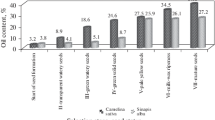Abstract
Changes in the fatty acids composition of the oil in flax and safflower seed that occur during the seed-ripening period have been measured. Concentrations of lipid or of specific fatty acid, expressed on a weight-per-seed basis, have been plotted as functions of days after fertilization and of percentage of oil development. Relations between these two independent variables have been established, and limitations to the unsefulness of the latter variable have been pointed out. Days after fertilization proved to be the more useful abscissa.
Nonpolar solvents were used to remove free lipid from the tissue, and the total extractable matter was separated into true lipid and nonlipid components. With both flax and safflower, weight of true free lipid per seed and total unsaturation increased during the same period of growth. Nonlipid extractable matter was an inverse function of the extent of development.
In developing flax seed, oleic, linoleic, and linolenic acids all increased continuously; oil in immature seed however was more saturated than oil in more mature seed. Nevertheless the ratio of linolenic acid to linoleic acid that characterizes linseed oil was established by the 20th day after fertilization during a normal growing season.
In developing safflower seed, oleic acid concentration increased slowly during the first 30 days after fertilization and then appeared to level off in some cases as maturity was approached. Initially linoleic acid was present in almost the same amount as oleic acid, but by the 20th day after fertilization its concentration was three times that of oleic acid. This ratio of linoleic to oleic acid tended to increase steadily during the latter part of seed development.
Similar content being viewed by others
References
Sims, R.P.A., McGregor, W.G., Plessers, A.G., and Mes, J.C., J. Am. Oil Chemists’ Soc.,38, 273–276 (1961).
Simmons, R.O., and Quackenbush, F.W., J. Am. Oil Chemists’ Soc.,31, 601–603 (1954).
Crombie, W.M., J. Exp. Bot.7, 181–193 (1956).
Vidal, A.A., Rev. Fac. Agron. La Plata,32, 159–171 (1956). (C.A.,25, 264a.)
Kartha, A.R.S., and Naraynan, R., J. Sci. Ind. Res.,18B, 41–48 (1959).
Painter, E.P., Arch. Biochem.,5, 337–348 (1944).
Lehberg, F.H., McGregor, W.G., and Geddes, W.F., Can. J. Res.17C, 181–194 (1939).
Hiscox, D.J., Anal. Chem.,20, 679–680 (1948).
Vandenheuvel, F.A., J. Am. Oil Chemists’ Soc.,30, 104–110 (1953).
Author information
Authors and Affiliations
Additional information
Contribution No. 45 from the Genetics and Plant Breeding Research Institute, Research Branch, Canada Department of Agriculture, Ottawa.
About this article
Cite this article
Sims, R.P.A., McGregor, W.G., Plessers, A.G. et al. Lipid changes in maturing oil-bearing plants. II. Changes in fatty acid composition of flax and safflower seed oils. J Am Oil Chem Soc 38, 276–279 (1961). https://doi.org/10.1007/BF02638424
Received:
Issue Date:
DOI: https://doi.org/10.1007/BF02638424



